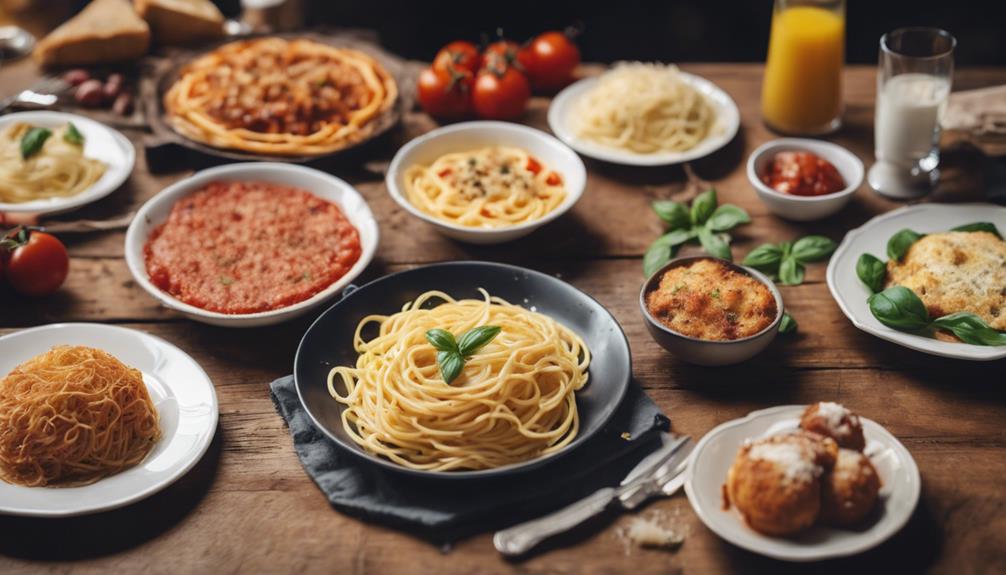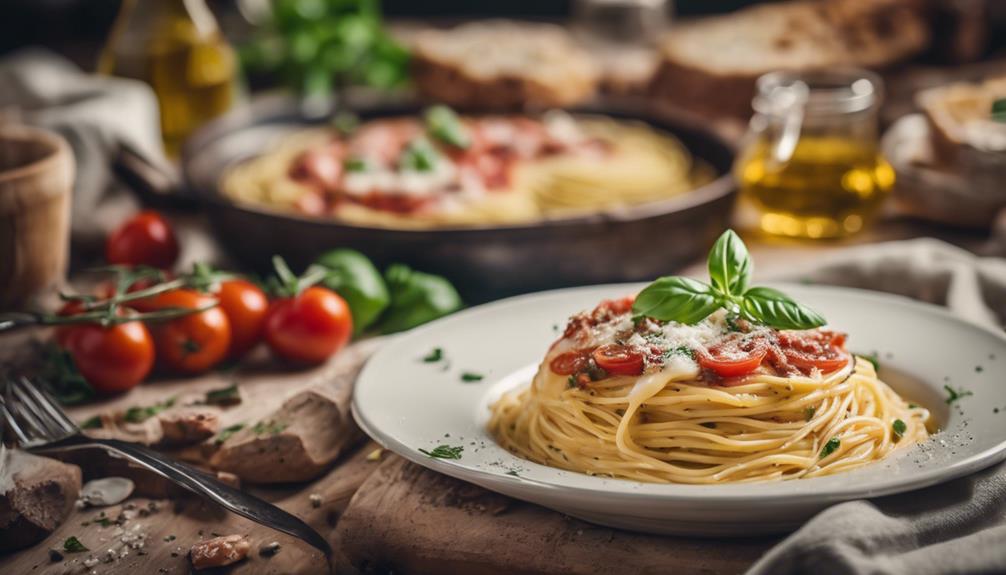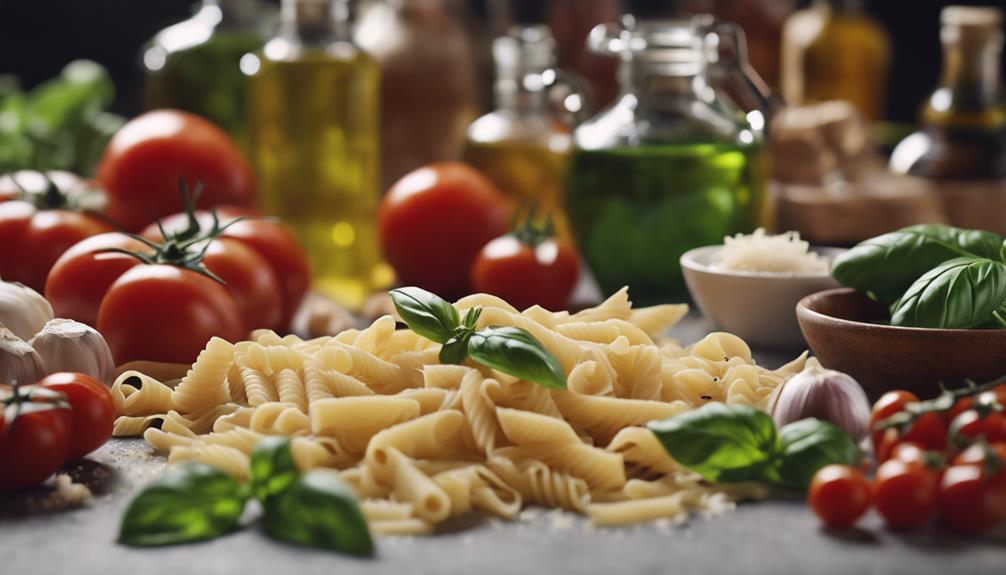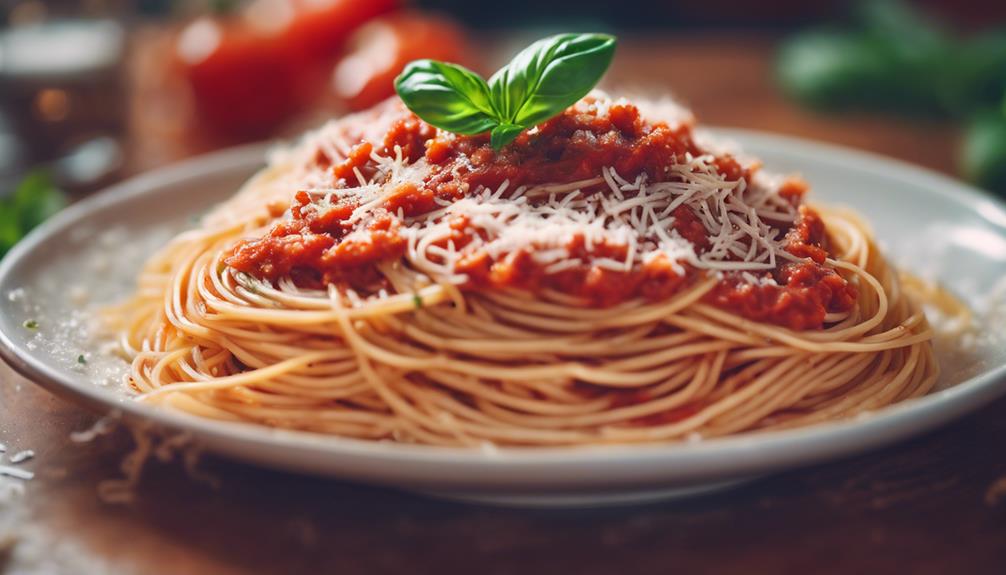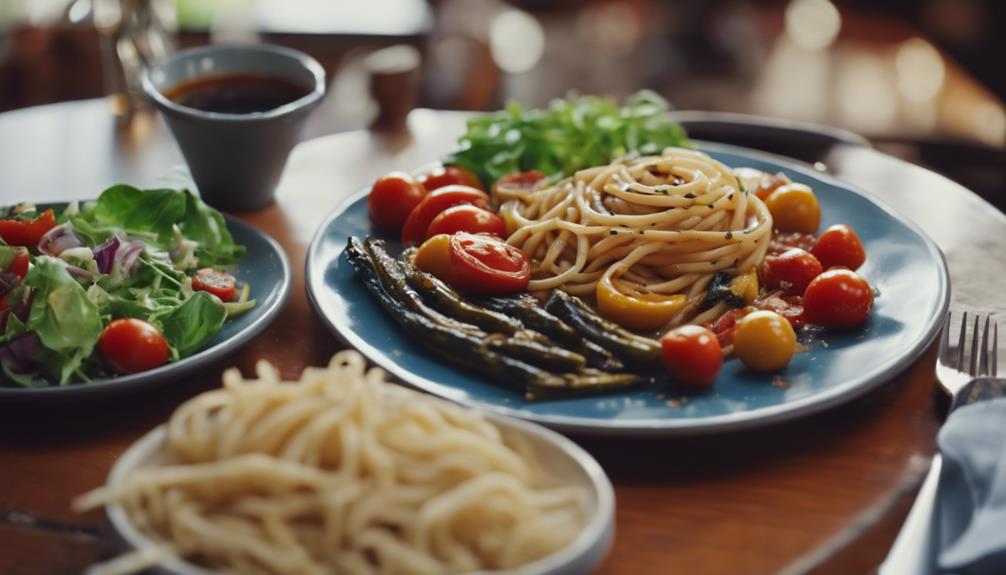When it comes to well-loved Italian dishes, pasta, pizza, risotto, seafood, lasagna, and tiramisu are the stars of the show. From the creamy goodness of risotto to the savory layers of lasagna, these culinary gems are sure to please your palate. Explore the endless options of pasta and the versatility of pizza toppings and crusts. Treat yourself to the deliciousness of seafood dishes steeped in tradition. Finish off your meal with the beloved tiramisu, a sweet indulgence made with mascarpone cheese, cream, coffee, and Marsala. Continue to discover more delightful Italian delicacies.
Key Takeaways
- Pasta: Diverse creations, Sicilian origins.
- Pizza: UNESCO recognized, Neapolitan roots.
- Risotto: Creamy delicacy, saffron-infused Milanese classic.
- Seafood: Coastal tradition, Christmas Eve feast.
- Lasagna: Iconic layers, rich textures, versatile.
- Tiramisu: Veneto origins, mascarpone richness, coffee-infused sweetness.
Pasta
Pasta, originating in Sicily and now a staple in Italian cuisine, offers endless possibilities for delicious creations. Italian cuisine boasts a plethora of famous pasta dishes that have captivated taste buds worldwide.
Traditional Italian dishes such as spaghetti alla carbonara, a creamy blend of eggs, cheese, pancetta, and black pepper, exhibit the simplicity and richness that define Italian cooking. The allure of fresh pasta, handmade with care and attention to detail, elevates classics like lasagne and spaghetti Vongole to gourmet status.
When it comes to popular Italian dishes, pasta reigns supreme. The versatility of pasta allows for a myriad of flavors and textures, ensuring there's a pasta dish to suit every palate. From the comforting embrace of spaghetti Bolognese to the elegant simplicity of spaghetti aglio e olio, each pasta creation tells a story of tradition and innovation.
Pizza

Pizza, with its origins in Naples, Italy, has evolved into a beloved global culinary delight. The traditional Neapolitan Margherita pizza, adorned with mozzarella cheese, tomato sauce, and basil, remains a classic favorite across the world. UNESCO's recognition of pizza as Intangible Cultural Heritage highlights its cultural significance and historical roots in Naples.
- Naples: Known as the birthplace of pizza, Naples boasts a long-standing tradition of pizza-making that has been passed down through generations.
- UNESCO Recognition: Being acknowledged by UNESCO as Intangible Cultural Heritage solidifies pizza's cultural importance and heritage, elevating it beyond just a dish.
- Variety: While the Margherita pizza is a staple, the beauty of pizza lies in its versatility. From thin-crust to deep-dish, and toppings ranging from classic pepperoni to gourmet combinations, there's a pizza for every palate.
Pizza's journey from a humble Neapolitan creation to a global phenomenon showcases the power of simple ingredients and a shared love for good food.
Risotto
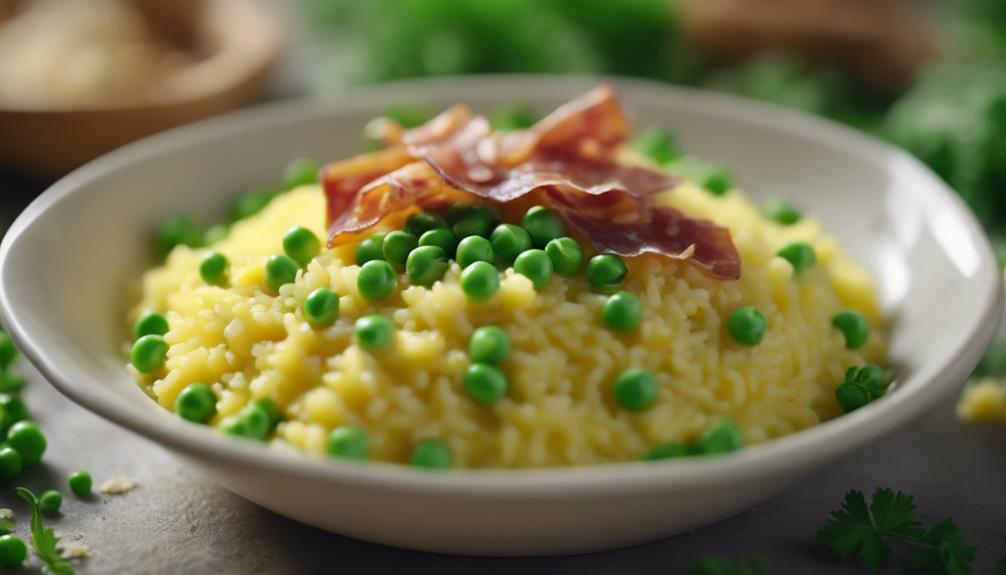
Risotto, a creamy Northern Italian delight, offers a world of possibilities when it comes to flavors and ingredients. Making risotto involves simmering rice in broth until it becomes luxuriously smooth and delectable.
Are you ready to explore the various types of risotto and learn some pro tips for mastering this classic Italian dish?
Risotto Varieties
When exploring the world of Italian cuisine, you'll find an array of delectable risotto varieties to tantalize your taste buds. Risotto is renowned for its creamy texture and rich flavors, making it a beloved dish across the globe.
Here are three must-try risotto varieties:
- Risotto alla Milanese: Originating from Milan, this luxurious risotto is infused with saffron, giving it a vibrant yellow hue and a subtle earthy flavor that pairs perfectly with the creamy rice base.
- Risotto ai Funghi: For mushroom lovers, this risotto variety is a dream come true. The earthy and umami notes of the mushrooms combined with the velvety Arborio rice create a comforting and satisfying dish.
- Seafood and Vegetable Risotto: Embrace the freshness of the sea or garden by adding seafood like shrimp, clams, or vegetables like asparagus and peas to your risotto. The combination of delicate flavors and textures will elevate your risotto experience to new heights.
Risotto Cooking Tips
Consider using Arborio, Carnaroli, or Vialone Nano rice for an authentic risotto experience that promises a creamy texture. To achieve that velvety consistency, stir constantly while gradually adding warm broth to release the rice's starch. This technique helps create that signature creamy texture risotto is known for.
Don't forget the final touches – enrich your risotto with butter and the flavorful kick of Parmigiano-Reggiano cheese. These additions not only enhance the taste but also contribute to the richness of the dish.
When it comes to making risotto, the possibilities are endless. Experiment with various ingredients like mushrooms, seafood, or saffron to create unique and delicious variations.
Seafood
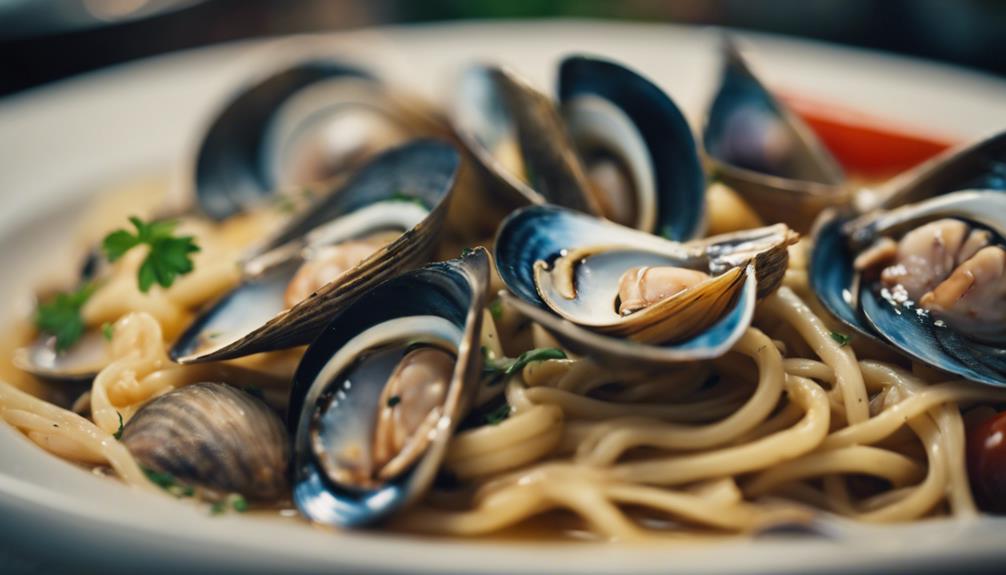
When it comes to Italian cuisine, seafood plays a significant role in tantalizing taste buds.
From the coastal regions to the heart of the country, seafood dishes are savored with passion and tradition.
Get ready to explore the delicious world of popular Italian seafood delights.
Seafood in Italian Cuisine
Seafood plays a significant role in Italian cuisine, featuring prominently in many traditional dishes. Here are three reasons why seafood holds such importance in Italian culinary culture:
- Christmas Eve Dinner: In Italy, seafood takes center stage on Christmas Eve, where families gather to enjoy a feast of various seafood dishes like baccalà (salted cod), calamari, and shellfish. This tradition, known as the Feast of the Seven Fishes, reflects the country's deep-rooted connection to seafood.
- Italian-American Cuisine: Italian-Americans have adopted the tradition of elaborate seafood feasts, especially during holidays and celebrations. This fusion of Italian culinary heritage with American influences has led to the creation of unique seafood dishes that pay homage to both cultures.
- Culinary Versatility and Coastal Influence: The diverse use of seafood in Italian cuisine showcases the country's culinary versatility and coastal influence. From classic dishes like linguine alle vongole (linguine with clams) to innovative seafood creations, Italian chefs continue to push the boundaries of traditional seafood recipes.
Popular Italian Seafood Dishes
Italian cuisine features a wide array of popular seafood dishes that highlight the country's rich culinary heritage and coastal influences. Common seafood staples like shrimp, mussels, sardines, squid, and cod are prevalent in traditional Italian dishes, showcasing the deep connection to the sea.
In Italian-American cuisine, elaborate seafood feasts, such as the famous Christmas Eve 'Feast of the Seven Fishes,' are a confirmation of the importance of seafood in cultural traditions.
The diverse seafood options in Italian gastronomy reflect the country's varied regions and culinary practices. From the Mediterranean coast to the Adriatic Sea, each region offers unique seafood specialties that have become beloved classics.
Whether it's a simple seafood pasta dish or a lavish seafood platter, Italians know how to make the most of their coastal bounty. So, next time you crave something from the sea, immerse yourself in the flavors of Italy and savor the delicious seafood dishes that have stood the test of time.
Seafood Regions in Italy
Explore the diverse coastal regions of Italy to discover the vibrant culinary traditions rooted in fresh and abundant seafood dishes. From Sicily to Sardinia and Campania, these areas boast a rich seafood heritage that has influenced traditional Italian cuisine for generations.
- Abundant Seafood Dishes: Italy's coastal regions are famous for their array of seafood offerings, including shrimp, mussels, sardines, squid, and cod, which are often featured in traditional Italian seafood dishes.
- Feast of the Seven Fishes: Seafood plays a significant role in Italian cuisine, especially during festive occasions like the Christmas Eve dinner known as the Feast of the Seven Fishes, where families gather to enjoy a feast of various seafood dishes.
- Italian-American Cuisine: Italian-American cuisine also celebrates seafood with elaborate feasts that showcase different types of seafood, reflecting the culinary heritage passed down through generations and the versatility of seafood in Italian cooking.
Lasagna
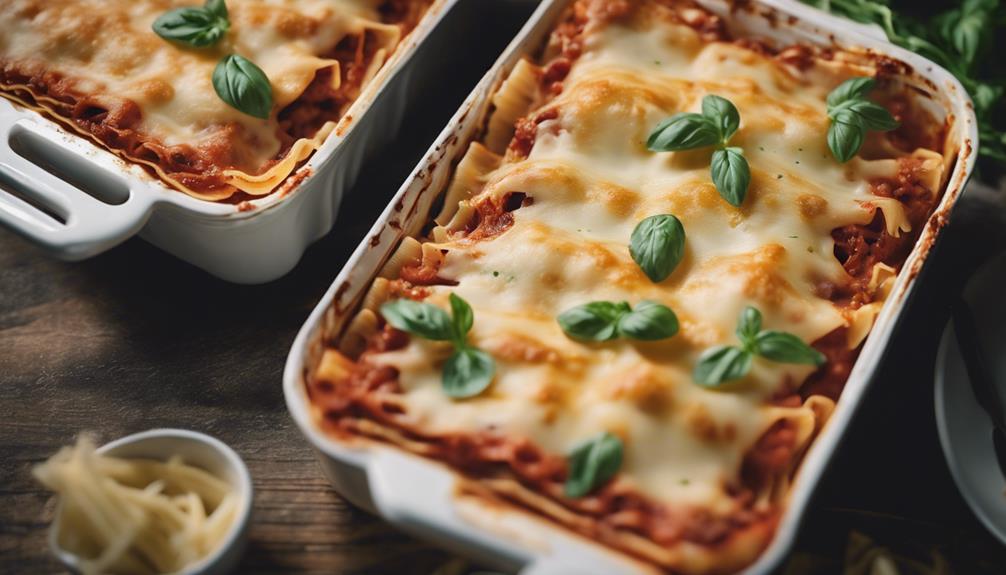
Experiencing the layers of savory goodness in a well-made lasagna can truly transport your taste buds to Italy's culinary heart. This famous Italian dish is a true comfort food, with each bite offering a symphony of flavors.
Picture this: tender pasta sheets embracing a rich meaty ragu, decadent creamy bechamel sauce, and a generous sprinkle of tangy Parmigiano Reggiano cheese. The combination of these elements creates a mouthwatering experience that's hard to resist.
Lasagna isn't just any dish; it's a representation of Italy's culinary excellence. The careful layering of ingredients and the slow baking process result in a dish that's both hearty and indulgent. When you savor a slice of authentic lasagna in Italy, you'll understand why it's a staple on every Italian food list.
The traditional preparation and the depth of flavors make it a standout dish that's hard to replicate elsewhere. So, next time you're craving something truly satisfying, treat yourself to a plate of lasagna and let your taste buds thank you.
Tiramisu
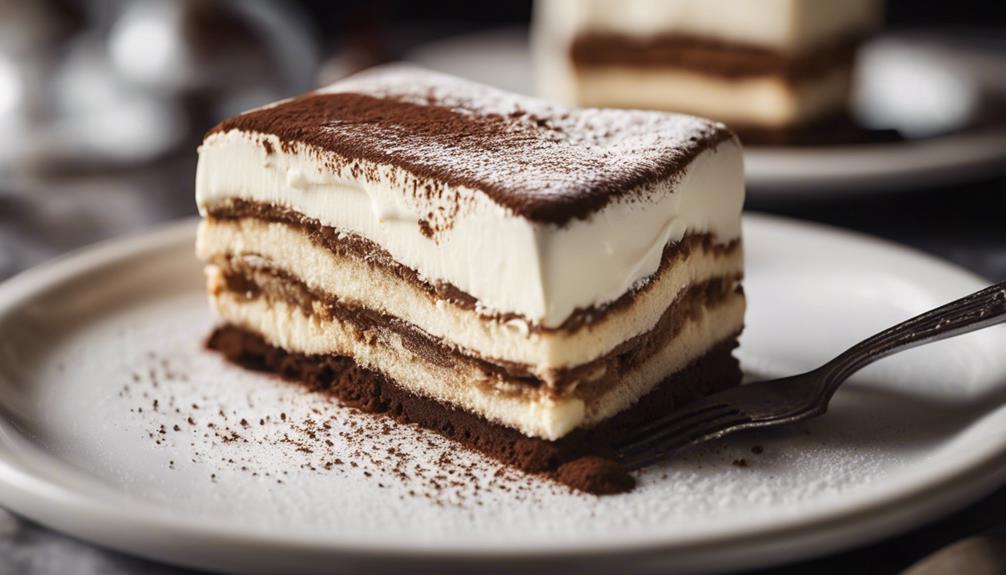
Indulge in the decadent layers of Tiramisu, a beloved Italian dessert originating from the Veneto region. This iconic treat combines the richness of mascarpone cheese, the sweetness of cream, and the bold flavors of coffee and Marsala.
Here are three key elements that make Tiramisu a favorite worldwide:
- Savoiardi Biscuits: These ladyfinger biscuits are dipped in coffee and Marsala, adding a delightful hint of bitterness and a subtle kick of alcohol to each layer of the dessert.
- Mascarpone Cheese: The luscious and creamy filling of Tiramisu is crafted using mascarpone cheese, a versatile Italian ingredient known for its smooth texture and mild tanginess.
- Cocoa Powder: Tiramisu is traditionally dusted with cocoa powder, providing a bittersweet contrast to the creamy layers and adding a depth of flavor that enhances the overall indulgence of this classic dessert.
With its perfect balance of flavors and textures, Tiramisu continues to captivate taste buds around the globe, making it a must-try for dessert enthusiasts everywhere.
Frequently Asked Questions
What Are the Top 10 Italian Dishes?
You should explore the top 10 Italian dishes for a culinary adventure. From Spaghetti alla Carbonara to Napoletana Pizza, Risotto, Arancini, and Fiorentina Steak, these traditional favorites offer a taste of Italy's rich flavors.
What Are 5 Traditional Italian Dishes?
When it comes to traditional Italian dishes, you'll find staples like Spaghetti alla Carbonara, Napoletana Pizza, Risotto, Arancini, and Fiorentina Steak. These classics showcase the diverse and delicious flavors of Italian cuisine that you'll adore.
What Are 3 Major Food Dishes in Italy?
When in Italy, try three major food dishes: Spaghetti alla Carbonara with cheese, eggs, guanciale, and pepper; Napoletana Pizza cooked in a wood-fired oven with tomatoes, Mozzarella, and basil; and Risotto, a luxurious dish with various versions. Enjoy!
What Is the Most Popular Italian Dish in America?
When in America, indulge in the most beloved Italian dish – pizza. Over 3 billion sold yearly, it's a top pick. Pasta favorites like spaghetti and lasagna also rank high. Don't forget tiramisu for dessert!
Are Famous Italian Dishes Also Considered Popular in Italy?
Yes, the famous Italian dishes list is also popular in Italy. Dishes like pasta carbonara, risotto, and tiramisu are cherished by locals and tourists alike. Italian cuisine celebrates simplicity and quality ingredients, making these dishes a constant favorite in the country.
Conclusion
To sum up, Italian cuisine offers a variety of delicious dishes that are loved worldwide. Did you know that pasta is the most popular Italian dish, with the average Italian consuming about 60 pounds of pasta per year?
From savory pizzas to creamy risottos, there's something for everyone to enjoy in Italian cooking. So next time you're craving some Italian flavors, don't hesitate to indulge in these mouth-watering classics! Buon appetito!
